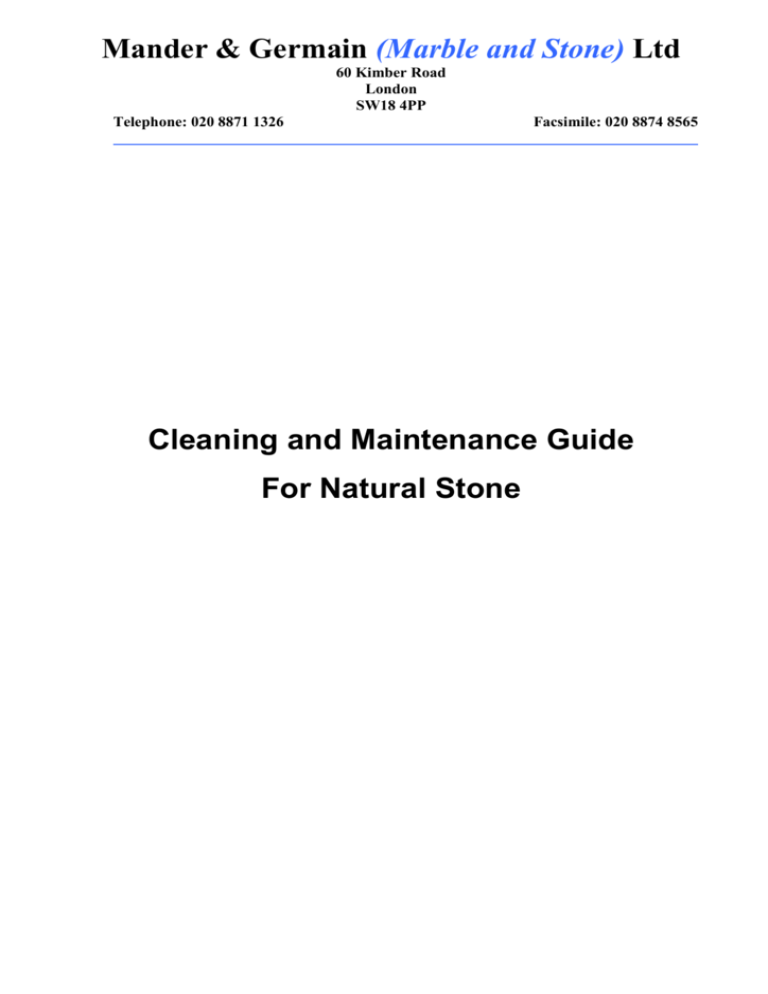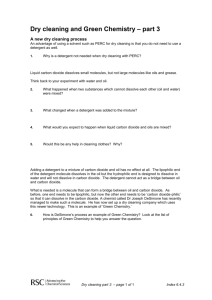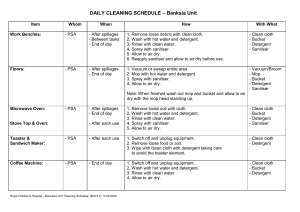Mander & Germain (Marble and Stone) Ltd
advertisement

Mander & Germain (Marble and Stone) Ltd 60 Kimber Road London SW18 4PP Telephone: 020 8871 1326 Facsimile: 020 8874 8565 Cleaning and Maintenance Guide For Natural Stone Contents Page 1. General 3 2. Cleaning Agents 3 3. Floors 4 3.1 General 4 3.2 Methods 4 3.2.1 Using Electrical Equipment 4 3.2.2 Sweeping and Mopping 5 4. Kitchen Work surfaces 6 5. Bathroom Vanitory and Bath Tops 6 6. Vertical Surfaces 6 6.1 Internal Marble 6 6.2 External Marble with a Honed Finish 7 6.3 External Marble with a Polished Finish 7 6.4 Granite 8 6.5 Limestone and Sandstone 8 6.6 Slate and Quartzite 8 Silicon and Grout 9 7.1 Silicon 9 7.2 Grout 9 7. 1. General To enjoy the beauty of the stone for many years it is essential that a general maintenance routine is carried out on a regular basis. This should ensure that surfaces are kept clean by washing using a mild detergent followed by rinsing in clean water and buffing dry with a clean cloth. It is important that any spillage of whatever nature is removed as quickly as possible as although surfaces are sealed when necessary this cannot provide complete protection in all cases. Finishes will not be damaged by the occasional us of fine abrasive cleaners to remove particularly stubborn blemishes. However regular use of scrub and rub cleaning machines fitted with abrasive pads, other that the finest grades, is likely to damage the surface and may result in the gradual loss of thickness in the wear layer. Damage can occur by misuse or incorrect maintenance due to inadequate initial instructions. Personnel responsible for maintenance should be given full information concerning any particular risks of misuse likely to occur and this information should include recommendations for cleaning. 2. Cleaning Agents Effective cleaning can usually be achieved by normal washing or scrubbing with warm water and a neutral sulphate-free detergent. Greasy deposits can be removed by detergent incorporating an organic or an alkaline detergent (pH>9), but these should only be used for occasional cleaning. It is essential that only a mild detergent, such as Mild Green Fairy Liquid is used on a regular basis. The occasional use of abrasive cleaners can be beneficial in the event of particularly stubborn blemishes. Household soaps are not recommended as they tend to leave a slippery scum, particularly in hard water areas. It is important to ensure that the cleaning agent is completely removed by a final rinse with clean water. ____________________________________________________________________ 3 3. Floors 3.1 General Wet vacuuming and dry buffing with a electric polisher is the most effective way of maintaining the best appearance of a stone floor. Sweeping and mopping can also be used although it is important that only a soft brush is used to avoid scratches and to trap as much dirt as possible and also the water must be changed frequently to avoid putting dirty water back on to the floor. In time, limestone floors will always show signs of ageing due to the nature of its pours. However, in our opinion this does add to the beauty of the material. 3.2 Methods 3.2.1 Using Electrical Equipment Remove any spills with a damp cloth and vacuum up soiling with a well diluted mild detergent in a bucket of warm water. Rinse the floor in clean water using a well wrung out cotton mop then wet vacuum again. Allow the floor to dry and then lightly buff with a green or blue pad on the polisher to remove smears. ____________________________________________________________________ 4 3.2 Methods continued 3.2.2 Sweeping and Mopping Remove any spills with a damp cloth then sweep or dry vacuum the floor. Use a mild detergent in a bucket of warm water, then mop. Use a scrubbing brush on any stubborn marks. Rinse the mop well, then rinse the floor with plenty of clean water. Leave to dry and buff away smears with a dry cloth. For an occasional thorough clean, follow guidelines above but use a long handled scrubbing brush instead of a mop. Avoid scratching the surface, use liquid cleaners rather than abrasive cleaners, (e.g. Vim). It is helpful if adequate external and internal barrier mats can be used in Entrance areas as it is important to reduce the amount of grit carried on to the stone floor. Do not use acid (e.g. brick acid) to clean stone without specialist advice. It can etch the surface of some stones permanently. Also do not use anything sharp such as a knife to dislodge dirt, but scrub instead. ____________________________________________________________________ 5 4. Kitchen Worksurfaces All honed worktops are sealed before leaving our factory and this provides an effective stain, oil and water repellent which is entirely safe in food and preparation areas. The majority of polished granite worktops do not require sealing as the surface naturally repels spillages, however it is always best to wipe clean as soon as possible as certain spills of an acidic nature, e.g. red wine, lemon juice, vinegar and colas could stain if left too long. Tops normally only require a wipe over with a clean cloth, then a buff with a dry cloth to remove any smears. If grease or oil builds up use a little detergent and warm water, then rinse away with clean water and buff dry with a clean cloth. For stubborn marks, scrub with a white nylon scourer or relatively soft scrubbing brush. Do not use a knife directly on the stone, always chop on a suitable board to avoid scratching the surface. Do not put hot pans directly on the stone, use suitable barrier mats. 5. Bathroom Vanitory and Bath Tops All marble and limestone tops are sealed before leaving our factory, however, although this will provide reasonable protection it is advisable to remove any spillage as quickly as possible. Perfumes and contract lens fluid will remove the polish if left on too long. Generally tops should be wiped down with a clean duster prior to washing with warm water and mild detergent. Rinse with clean water then buff with a clean cloth. ____________________________________________________________________ 6 6. Vertical Surfaces 6.1 Internal Marble Very little maintenance is required on marble used internally other than keeping clean. Wiping down with a clean duster is useful. An occasional wash down, e.g. annually, with a leather can help. Every few years it may be useful to apply a silicone clear wax polish and buff up. 6.2 External Marble with a honed finish Usually only marble of the lighter colours will be used in external locations and very little maintenance should be necessary. An occasional wash down with clean water is all this is usually required. A mild detergent can be added if necessary. 6.3 External Marble with a polished finish To retain a highly polished finish in exposed conditions the marble will need to be thoroughly cleaned with water and detergent if necessary, at least twice a year and a silicone clear wax polish applied with a buffer. This will retain the polished finish. If the marble is protected under a canopy, then depending on conditions, the frequency may be less, say once every 9 to 12 months. Black and dark coloured marbles lose their polish more rapidly and therefore are not recommended for external use. However if used it is essential that maintenance is carried out more frequently than for lighter coloured marbles. ____________________________________________________________________ 7 6. Vertical Surfaces continued 6.4 Granite Most granite’s with a polished face will retain their polish and colour for a great many years and the only maintenance required is regular washing with clean water to remove surface dirt. Granite facings with a textured finish normally only require occasional washing with clean water to remove surface dirt, but it may be necessary in some atmospheres, particularly if maintenance has note been carried out for some considerable time, to assist dirt removal with a bristle or nonferrous brush, or to use proprietary cleaning liquids, though extreme care should be taken to follow the manufacturer’s instructions in each case and a small sample area should be treated first. 6.5 Limestone and Sandstone In town atmospheres, stone facing acquires a coating of dust and dirt. To maintain the colour and texture of the stone and to keep the building in such state that its surfaces will reflect and diffuse more light, it is recommended that the face is cleaned every 5 to 10 years according to the amount of discolouration the facing suffers. Washing with clean water and scrubbing with bristle brushes will maintain the appearance of the stone work and remove atmospheric deposits conducive to decay. 6.6 Slate and Quartzite Apart from the periodical inspection of slate and quartzite for any delamination and repointing where necessary, no other maintenance is normally required other than washing. ____________________________________________________________________ 8 7. Silicon and Grout 7.1 Silicon This is generally used in internal corners in showers and between tops and splashbacks. The silicon should be inspected every say 6 months, particulary in shower cubicles to check that it is still preventing water penetration. 7.2 Grout The grout used incorporates a flexible additive but can still crack where movement occurs in the structure. Therefore, in time, the grout may need raking out and re-grouting. ____________________________________________________________________ 9








